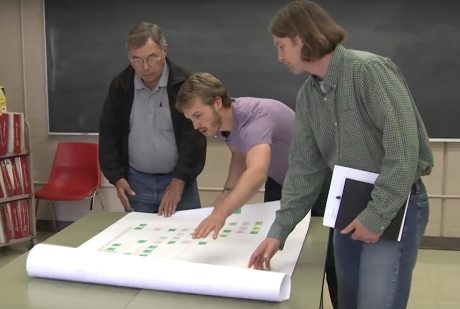Uranium mining and milling contribute only a small amount to nuclear energy's already low greenhouse gas emissions, the first comprehensive life cycle assessment of greenhouse gas emissions produced from Canadian uranium mining operations has found.
 |
| (L-R) Gordon Sparks, David Parker (both University of Saskatchewan) and Cameron McNaughton (Golder Associates) who carried out the work (Image: Fedoruk Centre) |
The work by David Parker, Cameron McNaughton and Gordon Sparks has been published in Environmental Science and Technology, an online peer-reviewed journal.
The life cycle assessment involved gathering information on all the greenhouse gases emitted by everything used in the mining and milling of uranium at three Saskatchewan sites, including fuel used in heavy machinery and to power facilities, the concrete and steel used in construction, emissions from flying workers to and from the mine sites and even took into account emissions from company head offices.
The researchers also visited mine and mill sites and worked alongside uranium producers Areva and Cameco. They found the dominant sources of emissions to be the electricity consumed and the propane used for heating at the sites in northern Saskatchewan.
They found that uranium mining and milling contributes about 1 gram of CO2 equivalent per kilowatt-hour of electricity generated from the uranium. "Saskatchewan has the highest grade uranium in the world, and the emissions from uranium mining in Canada are very, very low when compared to extracting fossil fuels," Parker, a graduate student at the University of Saskatchewan College of Engineering, said.
"We hypothesized that the emissions from the mining and milling of uranium would be low, and we're finding that's the case - and they're even lower than we had expected at the start," McNaughton, an environmental engineer at Saskatoon-based Golder Associates, said in a video explaining the work.
2014 figures from the United Nations Intergovernmental Panel on Climate Change cite a mid-range value of 12 grams CO2 equivalent per kilowatt hour for nuclear power, which is similar to wind power, while coal produces over 800 grams per kilowatt hour and natural gas about 500 grams.
"Many people think that the mining and milling of uranium is a hidden source of greenhouse gas emissions related to nuclear power - that it’s the dirty end of the stick", McNaughton said. "This study, which is the most rigorous done to date, showed that the mining and milling of uranium produces only a small amount of emissions."
The work was funded through a grant from the University of Saskatchewan's Fedoruk Centre, which was established in 2011 as the Canadian Centre for Nuclear Innovation. The researchers hope to expand their work to look at the impact of ore grade and different mining processes on emissions as well as broadening it to consider other environmental impacts beyond greenhouse gases.
Researched and written
by World Nuclear News




_18570.jpg)
_16159.jpg)
_18938.jpg)
_33584.jpg)





